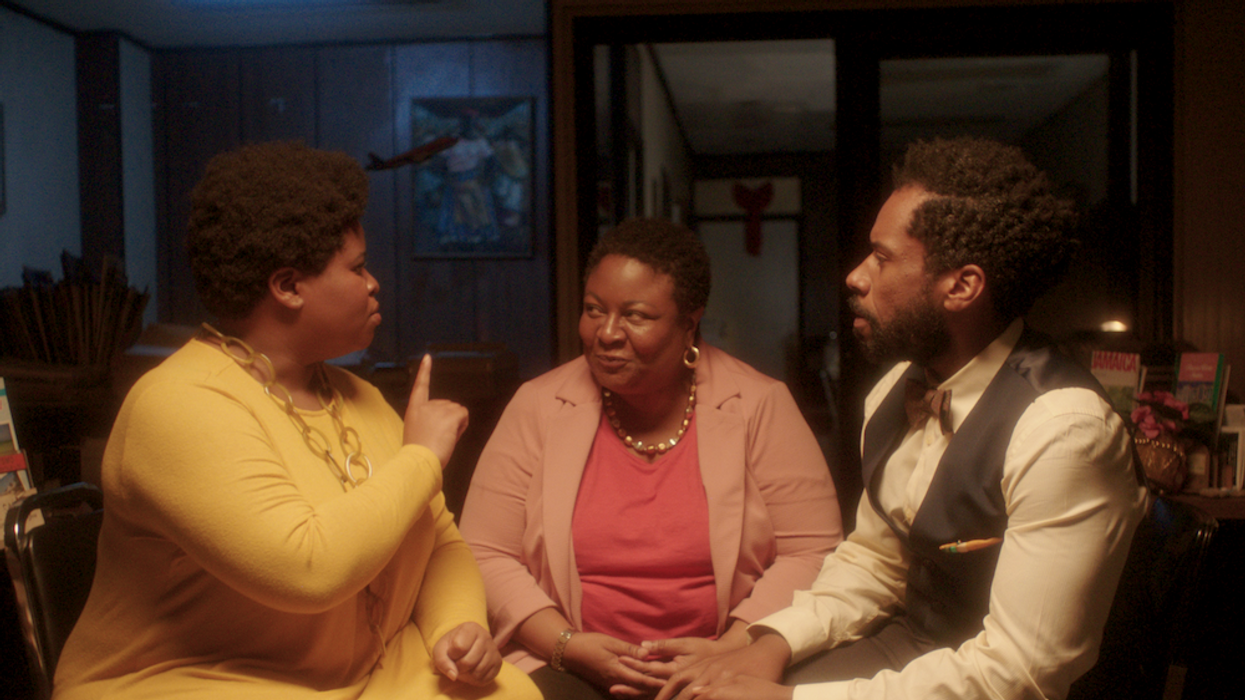How to Make Period Pieces on a Micro-Budget
Want to make a period film but think you can't afford it? Think again.

Every film project I have ever directed has been ultra-low budget. I sadly do not know what it is to pay people what they’re worth. I haven’t had the pleasure of using a Steadicam or a dolly that wasn’t secretly a wheelchair or a pair of deceptively long speed rails. So last year, when I received a budget that was six times the largest sum I had previously attained, I did not scale up in a traditional fashion with a more manageable schedule or larger crew. Instead, we shot 60 pages in seven days across two time periods, neither of which was the present.
Predominantly set mid-1990s Brooklyn, The Future is Then follows Glenda (Myra Lucretia Taylor), a recently widowed Trinidadian travel agent, who is poached by three, white, 20-something tech bros to run their Expedia-style start-up. It premiered in the N.O.W. section of this year’s Tribeca Film Festival and is currently available for viewing through BRIC TV. Below are some tips and tricks I learned from pre- to post-production that allowed us to realize multiple time periods on an ultra-low budget.
Location, Location, Location
I would not have been able to make The Future is Then without the participation of a particular travel agency in Brooklyn. The reason for this is twofold: first, the proprietor of said agency inspired the show’s lead character, and second, I wrote the script knowing we would be allowed to shoot at her office. The travel agency has been in business since the 1960s, and the décor is something of a late 20th century time capsule. When it comes to production design, it’s always easier to subtract than to add, and the location afforded us with the perfect skeleton.
The carpeting, desks, typewriters, and posters were neutral enough that we could convert the surroundings to both the 1970s and 1990s by reordering available props. The main office features in both decades and the dressing remained more or less the same, in line with the underpinning conceit that the travel agency was steadfast in its way of business. We simply added an archaic calculating device and swapped the phones for the ‘70s sequence, and let the costumes do the heavy lifting.

Scour Prop Houses for Period Rentals
Because the bulk of the narrative takes place during the dot-com boom and explores the cultural differences between an old school travel agent and ‘new school’ tech engineers, period computers were a must – at least part of the time. I decided to deepen the contrast between the travel agency and start-up by making the former entirely analog and computer free. This meant we only needed to get two period desktop computers for the two computer engineer characters, John (Carl Kranz) and Matt (Stephen Gurewitz).
My production designer, Nina Macintosh, managed to find a couple of Macs at a prop warehouse for next to nothing, which meant we didn’t have to waste money purchasing them for a few hundred on eBay. Period pieces tend to rack up prop costs when you invest in vintage products for the length of the shoot that can’t be returned, and rentals are obviously a great way around this crunch. On the other hand, the script called for functioning computers, and the rentals turned on, but couldn’t do much else. Which brings me to my next item…
Set Aside Money for Compositing
Whatever money you are saving on props, make sure you set it aside for some Chroma key tape and compositing in post. I worked with Institution Post to create motion graphics and composites for the computers as well as the commercial sequences. This is typically a very costly process that was done at well below the market rate out of sheer generosity. It never hurts to ask for a favor -- all that can happen is they say “no”.

Aspect Ratios and Framing Out Are Your Friends
I made the decision to shoot all sequences involving the tech company in 4:3, which allowed me to frame out location details that were not to period specifications, like lights, mounted televisions, and so forth. For the remaining scenes that were in 16:9, I used wides sparingly – most often in the travel agency where I could control the set dressing. I never used the same set-ups twice across the 1970s and 1990s scenes to ensure that the space felt slightly dissimilar to the viewer. For street scenes, I found neutral backdrops in old storefronts and brownstones and stuck as close to them – and away from cars! – as possible.

Consider Archival Footage
A portion of the series’ narrative unfolds through commercials, and I used the free online Prelinger Archives to source a trove of material for compositing and stand-alone footage. I devised the commercial motif as a dreamscape for Glenda, knowing that I would be able to showcase a variety of images for no more than the cost of one-day at a cyc. Creative solutions at the script stage will save you many headaches when trying to pull off multiple time periods in multiple locations for very little money.

Wrapping Up
While the general consensus may be that you need a hefty sum to pull off a period piece, these tricks are well worth considering when executing one on a budget. The principal takeaway from my own experience was to lean into your limitations and allow them to become your strengths -- whether it’s pulling archival footage, using keys to compensate for older electronics, or getting as much mileage out of one location as possible.











